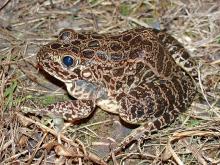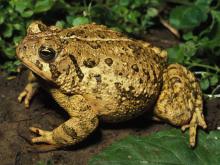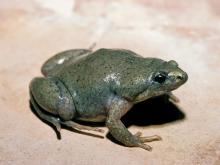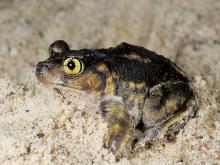Reptiles and Amphibians
Media

Species Types
Scientific Name
Lithobates sphenocephalus (formerly Rana sphenocephala)
Description
The southern leopard frog is an excellent jumper and quickly leaps into water when startled. From March through July, the males make chuckling or quacking calls from shallow water. Occurs statewide except for the northwestern corner.
Media

Species Types
Scientific Name
Lithobates blairi (formerly Rana blairi)
Description
A medium-sized spotted frog, the plains leopard frog lives in pastures, prairies, and marshes. The ridge of skin along each side of the back is broken, and a small hind section of it is shifted upward. It occurs nearly statewide, including the Bootheel, but is only rarely present in the Ozarks.
Media

Species Types
Scientific Name
Lithobates areolatus circulosus
Description
A very secretive species, the northern crawfish frog spends most of its time hidden burrows, typically those made by crayfish. It is restricted to native prairie or former prairie areas and is a species of conservation concern in Missouri.
Media

Species Types
Scientific Name
Anaxyrus americanus (formerly Bufo americanus)
Description
American toads are well-known and occur statewide. Missouri has two subspecies: the eastern American toad in the northern half, and the dwarf American toad in the southern half.
Media

Species Types
Scientific Name
Pseudacris maculata
Description
More often heard than seen, the boreal chorus frog calls with a vibrating “prrreeep” that rises in pitch at the end. It lasts one or two seconds and sounds like a fingernail scratched over the teeth of a pocket comb. It occurs nearly statewide, except for the southeastern quarter.
Media

Species Types
Scientific Name
Pseudacris crucifer
Description
The voices of spring peepers are a true announcement that winter is ending. These small, slender frogs can be several overall colors, but seeing an X on the back is a good way to ensure your identification.
Media

Species Types
Scientific Name
Gastrophryne olivacea
Description
The western narrow-mouthed toad has a plump body, short legs, uniform color, small, pointed head, and a fold of skin across the back of the head. The general color is gray, tan, or olive tan. In our state is is reported from far western Missouri and east along the Missouri River as far as the center of the state.
Media

Species Types
Scientific Name
Gastrophryne carolinensis
Description
The eastern narrow-mouthed toad is a plump little amphibian that is seldom seen. There is a fold of skin behind its narrow, pointed head. It occurs in the southern half of the state.
Media

Species Types
Scientific Name
Scaphiopus holbrookii
Description
The eastern spadefoot is a stout, toadlike amphibian with large, protruding eyes, vertically oval pupils, short legs, and large feet. In Missouri, it occurs in eastern counties along the Mississippi River and in the Bootheel.
Media

Species Types
Scientific Name
Anaxyrus cognatus
Description
Unlike other true toads in Missouri, the Great Plains toad has a raised hump between the eyes on the snout. Look for it along the Missouri River floodplain, from the Iowa border to about Hermann.
See Also
About Reptiles and Amphibians in Missouri
Missouri’s herptiles comprise 43 amphibians and 75 reptiles. Amphibians, including salamanders, toads, and frogs, are vertebrate animals that spend at least part of their life cycle in water. They usually have moist skin, lack scales or claws, and are ectothermal (cold-blooded), so they do not produce their own body heat the way birds and mammals do. Reptiles, including turtles, lizards, and snakes, are also vertebrates, and most are ectothermal, but unlike amphibians, reptiles have dry skin with scales, the ones with legs have claws, and they do not have to live part of their lives in water.





















